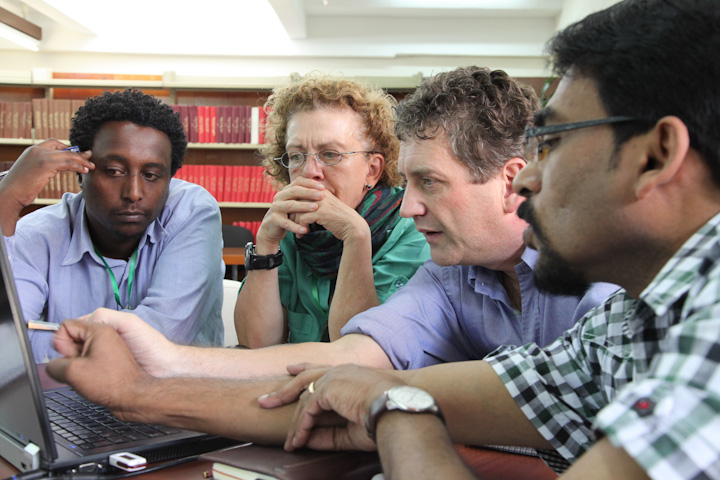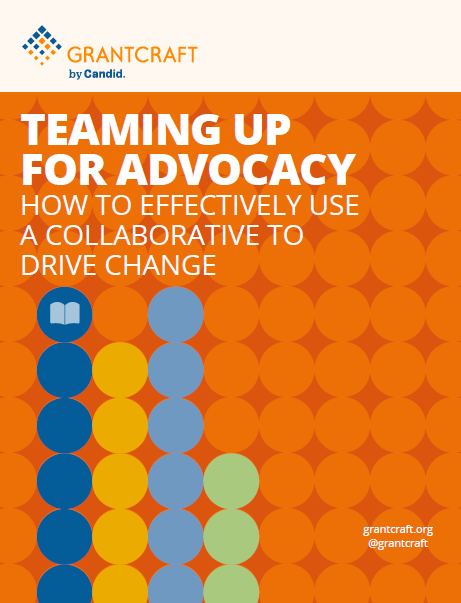Sticking Points: Groupthink
Groupthink—we all know it when we see it. Eyes glazing, heads bobbing, and everyone agreeing (even when they don’t). That can pop up in any kind of funder collaborative, but it can be more common in advocacy collaboratives because working in an ever-changing policy environment means less time for analysis and more demand for quick action. 
As one funder notes, “If you’re focused on really specific advocacy targets and you have only a certain amount of money to reach those targets and you’re relying pretty much on your colleagues and staff to determine whether you’ll be successful, it’s really easy to forget to take a step back and look more objectively at what you’re doing.” Collaboratives can be proactive in building preventive measures about groupthink into their processes from the get-go. “Participating funders need to be diligent about bringing in other perspectives and making sure the people at the table are comfortable expressing different views.”
That can be difficult if members were activists before they became funders—something that’s not uncommon in advocacy collaboratives. “This can be good and bad. Good, because it infuses the collaborative with first-hand experience and knowledge. Bad, because it can sometimes devolve into a small club of insiders who aren’t always objective.”
Groupthink also rears up when funders have very close relationships with their grantees and are committed to seeing them succeed—so much so that they’ll “tell their boards the collaboratives’ investments are good even when they suspect their grantees aren’t.”
Stories From the Real World
A funder collaborative working on federal-level immigration reform for several years was certain that—finally—a pending Supreme Court decision would swing their way. Unfortunately, that didn’t happen.
It was a huge blow no one saw coming. Millions of dollars went into that strategy, and we got it wrong. Why? I think it’s because we forgot to build into the strategy that we, as a group, had blind spots and didn’t figure out how to address them so that we’d be prepared if the decision didn’t go the way we wanted it to.
The member went on to share how the group should have interjected some accountability mechanisms into the process:
We should have role-played our board members asking us why we didn’t get the win we expected [if we lost] because it would have forced us to consider we might not win and come up with a clear answer about why we didn’t.
That can be difficult, though, because it requires getting honest information from grantees, who need to articulate what went wrong and expect funders to ask this—which doesn’t always happen.
That leads to a vacuum in doing the kind of post-analysis that’s needed to learn from mistakes. The danger is that the cycle can happen again when you have the same groups pitching the same kinds of strategies in front of a group of funders who never really were sure what went wrong initially.
Auspiciously, the collaborative was able to make lemonade out of lemons. Another member reported:
This failure actually forced us to take a hard look at our strategy and see whether it was feasible going forward. We decided to change it up and focus our efforts at the state level. [If the federal reform legislation had passed] our collaborative probably wouldn’t exist anymore or gone on to something else. Not winning the issue pushed us to redirect a lot of our resources and energy down to state-level policy work. Now, we’ve become more of a bottom-up entity, when we started as the opposite!
So how can funders involved in policy collaboratives stave off groupthink?
- Bring in outside experts to challenge the group’s assumptions. “It’s pretty easy to bring in dissenting voices—like people who are policy wonks or lobbyists or staffers from congressional offices. Some of the most effective people we’ve found to fill this role are those from the ‘opposition.’ They’re insiders who have a lot of knowledge, might have a different point of view and aren’t necessarily beholden to your grantees or funders.” Ask collaborative members to brainstorm a list of people who could potentially serve in this role and commit to inviting them to upcoming strategy discussions or grantmaking discussions.Relatedly, stop seeing people who disagree as “naysayers,” and instead, as valuable contributors to the planning or grantmaking process. One grantmaker says her collaborative deliberately pulls in people the group knows have no dog in the fight because they can be “honest brokers who aren’t aligned with the funders or the grantees to call you on your biases.” To help these folks do that well, it’s important that members ask clarifying questions and engage authentically in what should be a discussion, rather than a “debate.” Collaboratives can also ask each member to connect over coffee with a person with whom they disagree before the next meeting.
- Build constant questioning of who is being funded and why. Groupthink flourishes when there’s little or no pushback. But there’s usually not a lot of incentive for people to do that in the “nicey-nice” culture of the social sector. And there’s even less incentive for grantees to play that role. “Grantees tell funders what they want to hear so the money keeps flowing, and then you get to the end, and it’s a failure, you’re not sure where you started seeing danger or pushback because there wasn’t enough accountability as to how the money was being used along the way. There has to be ongoing accountability for your investments—individually and as a whole—to see how they’re panning out over time.”In short, members need to see constructive critique as an essential part of the group’s due diligence process. One way to do this is to make “poking holes” a standard part of every meeting, or, to empower a particularly strong group member to be the designated critic of every idea or approach. Some grantmakers set aside time in every meeting for presentations—about strategy, funding dockets, grantees, whatever—to suggest and consider potential downsides or challenges with each.
- Establish a more formal advisory council or structure. One education policy collaborative created an “education scholars advisory board” that provided knowledge and research to the members and their grantees about the issues, as well as potential strategies. “It was an incredible list of luminaries who provided a lot of value to grantees through learning networks and meetings, as well as our group of funders who benefited from their expertise and perspectives, including their ability to call out questionable data or decisions.”
- Recognize grantees as the experts they are. Funders can really fall into a bubble because they “tend to just talk to themselves. They need to talk to grantees and listen. Better yet, they need to take what they say into consideration in their decision making.” Another funder is blunter: “If you really want honesty, talk to people who think that what the grantees are saying to funders is BS.” One way to do that is to ask external advisors or intermediary staff members to interview grantees and, better yet, non-grantees about what’s working and what’s not, and why. Their responses can then be relayed back to funders unattributed.
NOW REFLECT:
- How much does our collaborative lapse into groupthink? Why does that happen? What can we do about it when it does?
- How comfortable do I feel about speaking up when I disagree with the group about something? What would make me feel more comfortable?
FURTHER READING:
- Lessons From a Ten-Year Funder Collaborative: A Case Study of the Partnership for Higher Education in Africa
- Smart Collaboration At the Grassroots Level: Emerging Lessons from Detroit's Community Connections Program
Please click here for information on GrantCraft’s methodology for this research.
(Photo: ILRI, licensed under CC BY-NC-SA 2.0)


